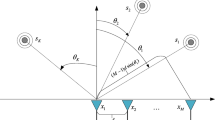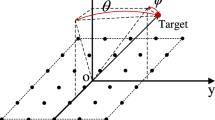Abstract
Manifold separation technique plays an important role in array modeling and signal processing for arbitrary arrays. By utilizing this technique, the atomic norm minimization (ANM) methods can be extended to the nonlinear arrays for DOA estimation via the generalized line spectral estimation approach. However, such an approach results in a high computational burden for the large-scale arrays. In this paper, a low-dimensional semidefinite programming (SDP) implementation to the coarray manifold separation atomic norm minimization (CMS-ANM) is proposed for a class of nonlinear arrays based on the compressed super-resolution of positive sources. The theoretical guarantee of the proposed SDP implementation for the exact recovery is presented, and the CMS-ANM-based low-complexity DOA estimation method is developed. The simulation results validate the theoretical analysis and demonstrate the satisfying trade-off for the performance and complexity.








Similar content being viewed by others
Data Availability
Data sharing is not applicable to this article as no data sets were generated or analyzed during the current study.
Notes
The code can be found at github.com/panda-1982/CMS-ANM.
References
F. Belloni, A. Richter, V. Koivunen, DOA estimation via manifold separation for arbitrary array structures. IEEE Trans. Signal Process. 55(10), 4800–4810 (2007). https://doi.org/10.1109/TSP.2007.896115
V. Chandrasekaran, M.I. Jordan, Computational and statistical tradeoffs via convex relaxation. Proc. Natl. Acad. Sci. 110(13), 1181–1190 (2013). https://doi.org/10.1073/pnas.1302293110
P. Chen, Z. Chen, Z. Cao, A new atomic norm for DOA estimation with gain-phase errors. IEEE Trans. Signal Process. 68, 4293–4306 (2020). https://doi.org/10.1109/TSP.2020.3010749
T. Chen, L. Shi, L. Guo, Gridless direction of arrival estimation exploiting sparse linear array. IEEE Signal Process. Lett. 27, 1625–1629 (2020). https://doi.org/10.1109/LSP.2020.3021276
Y. Chi, M..D.. Costa, Harnessing sparsity over the continuum: atomic norm minimization for superresolution. IEEE Signal Process. Mag. 37(2), 39–57 (2020). https://doi.org/10.1109/MSP.2019.2962209
R. Cohen, Y.C. Eldar, Sparse array design via fractal geometries. IEEE Trans. Signal Process. 68, 4797–4812 (2020). https://doi.org/10.1109/TSP.2020.3016772
M. Costa, V. Koivunen, Array processing in the face of nonidealities. Acad. Press Libr. Signal Process. 3, 819–857 (2014). https://doi.org/10.1016/B978-0-12-411597-2.00019-9
M. Costa, A. Richer, V. Koivunen, DOA and polarization estimation for arbitrary array configurations. IEEE Trans. Signal Process. 60(5), 2330–2343 (2012). https://doi.org/10.1109/TSP.2012.2187519
M. Costa, A. Richter, V. Koivunen, Unified array manifold decomposition based on spherical harmonics and 2-D Fourier basis. IEEE Trans. Signal Process. 55(9), 4634–4645 (2010). https://doi.org/10.1109/TSP.2010.2050315
M.D. Costa, Y. Chi, Compressed super-resolution of positive sources. IEEE Signal Process. Lett. 13, 947–960 (2021). https://doi.org/10.1109/LSP.2020.3045343
M. Coste: An introduction to semialgebraic geometry. Institut de Recherche Mathematique de Rennes pp. 819–857 (2002) https://perso.univ-rennes1.fr/michel.coste/polyens/SAG.pdf
Y. De Castro, F. Gamboa, D. Henrion, J.B. Lasserre, Exact solutions to super resolution on semi-algebraic domains in high dimensions. IEEE Trans. Inf. Theory 63(1), 621–630 (2017). https://doi.org/10.1109/TIT.2016.2619368
M. Doron, E. Doron, Wavefield modeling and array processing, part I, part II, and part III. IEEE Trans. Signal Process. 42(10), 2549–2580 (1994). https://doi.org/10.1109/78.324722
V. Duval, G. Peyre, Exact support recovery for sparse spikes deconvolution. Found. Comput. Math. 15(5), 1315–1355 (2015). https://doi.org/10.1007/s10208-014-9228-6
A. Eftekhari, J. Tanner, A. Thompson, B. Toader, Sparse non-negative super-resolution—simplified and stabilised. Appl. Comput. Harmonic Anal. 50, 216–280 (2021). https://doi.org/10.1016/j.acha.2019.08.004
M. Grant, S. Boyd: Cvx:matlab software for disciplined convex programming, version 2.0 beta (2013) http://cvxr.com/cvx
R. Heckel, M. Soltanolkotabi, Generalized line spectral estimation via convex optimization. IEEE Trans. Inf. Theory 64(6), 4001–4023 (2018). https://doi.org/10.1109/TIT.2017.2757003
S. Karlin, W. Studden, Tchebycheff Systems: With Applications in Analysis and Statistics. New York (1967). https://doi.org/10.2307/1401807
Y. Li, Y. Chi, Off-the-grid line spectrum denoising and estimation with multiple measurement vectors. IEEE Trans. Signal Process. 64(5), 1257–1269 (2016). https://doi.org/10.1109/TSP.2015.2496294
C.L. Liu, P. Vaidyanathan, Super nested arrays: linear sparse arrays with reduced mutual coupling—part I: fundamentals. IEEE Trans. Signal Process. 64(15), 3997–4012 (2016). https://doi.org/10.1109/TSP.2016.2558159
K. Mahata, M. Hyder, Grid-less TV norm minimization for DOA estimation. Signal Process. 132, 146–155 (2017). https://doi.org/10.1016/j.sigpro.2016.09.018
K. Mahata, M. Hyder, Fast frequency estimation with prior information. IEEE Trans. Signal Process. 66(1), 264–273 (2018). https://doi.org/10.1109/TSP.2017.2764865
H. Qiao, P. Pal, Gridless line spectrum estimation and low-rank Toeplitz matrix compression using structured samplers: a regularization-free approach. IEEE Trans. Signal Process. 65(9), 2221–2236 (2017). https://doi.org/10.1109/TSP.2017.2659644
A.G. Raj, J. McClellan, Single snapshot super-resolution DOA estimation for arbitrary array geometries. IEEE Signal Process. Lett. 26(1), 119–123 (2019). https://doi.org/10.1109/LSP.2018.2881927
F. Roemer, T. Hotz, G.D. Galdo: Grid-free direction-of-arrival estimation with compressed sensing and arbitrary antenna arrays, in IEEE International Conference on Acoustics, Speech and Signal Processing (ICASSP) (2018). https://doi.org/10.1109/ICASSP.2018.8462501
M. Rubsamen, A.B. Gershman, Sparse array design for azimuthal direction-of-arrival estimation. IEEE Trans. Signal Process. 59(12), 5957–5969 (2011). https://doi.org/10.1109/TSP.2011.2168222
S. Sedighi, B. Rao, B. Ottersten, An asymptotically efficient weighted least squares estimator for co-array-based DOA estimation. IEEE Trans. Signal Process. 68, 589–604 (2020). https://doi.org/10.1109/TSP.2019.2954506
S. Semper, F. Romer, ADMM for ND line spectral estimation using grid-free compressive sensing from multiple measurements with applications to DOA estimation, in IEEE International Conference on Acoustics, Speech and Signal Processing (ICASSP) (2019), pp. 4130–4134. https://doi.org/10.1109/ICASSP.2019.8683697
C. Steffens, M. Pesavento, M.E. Pfetsch, A compact formulation for the \(\ell _{2,1}\) mixed-norm minimization problem. IEEE Trans. Signal Process. 66(6), 1483–1497 (2018). https://doi.org/10.1109/TSP.2017.2788431
Z. Tan, Y.C. Eldar, A. Nehorai, Direction of arrival estimation using co-prime arrays: a super resolution viewpoint. IEEE Trans. Signal Process. 62(21), 5565–5576 (2014). https://doi.org/10.1109/TSP.2014.2354316
G. Tang, B.N. Bhaskar, P. Shah, B. Recht, Compressed sensing off the grid. IEEE Trans. Inf. Theory 59(11), 7465–7490 (2013). https://doi.org/10.1109/TIT.2013.2277451
K.C. Toh, R.H. Tutucu, M.J. Todd, On the implementation of SDPT3 (version 3.1)—a MATLAB software package for semidefinite-quadratic-linear programming, in IEEE International Symposium on Computer Aided Control Systems Design (2004). https://doi.org/10.1109/CACSD.2004.1393891
L. Vandenberghe, S. Boyd, Semidefinite programming. SIAM Rev. 38(1), 49–95 (1996). https://doi.org/10.1137/1038003
F. Wang, Z. Tian, G. Leus, J. Fang, Direction of arrival estimation of wideband sources using sparse linear arrays. IEEE Trans. Signal Process. (2021). https://doi.org/10.1109/TSP.2021.3094718
Y. Wang, Y. Zhang, Z. Tian, G. Leus, Super-resolution channel estimation for arbitrary arrays in hybrid millimeter-wave massive mimo systems. IEEE J. Sel. Top. Signal Process. 13, 947–960 (2019). https://doi.org/10.1109/JSTSP.2019.2937632
Z. Wei, W. Wang, F. Dong, Q. Liu, Gridless one-bit direction-of-arrival estimation via atomic norm denoising. IEEE Commun. Lett. 24(10), 2177–2181 (2020). https://doi.org/10.1109/LCOMM.2020.3000755
X. Wu, W. Zhu, J. Yan, A toeplitz covariance matrix reconstruction approach for direction-of-arrival estimation. IEEE Trans. Veh. Technol. 66(9), 8223–8237 (2017). https://doi.org/10.1109/TVT.2017.2695226
F. Xi, Y. Xiang, S. Chen, A. Nehorai, Gridless parameter estimation for one-bit mimo radar with time-varying thresholds. IEEE Trans. Signal Process. 68, 1048–1063 (2020). https://doi.org/10.1109/TSP.2020.2970343
Z. Yang, L. Xie, P. Stoica, Vandermonde decomposition of multilevel toeplitz matrices with application to multidimensional super-resolution. IEEE Trans. Inf. Theory 62(6), 3685–3701 (2016). https://doi.org/10.1109/tit.2016.2553041
Z. Yang, L. Xie, C. Zhang, A discretization-free sparse and parametric approach for linear array signal processing. IEEE Trans. Signal Process. 62(19), 4959–4973 (2014). https://doi.org/10.1109/TSP.2014.2339792
Y. Zhang, G. Zhang, X. Wang: Array covariance matrix-based atomic norm minimization for off-grid coherent direction-of-arrival estimation, in IEEE International Conference on Acoustics, Speech and Signal Processing (ICASSP) (2017), pp. 1503–1507. https://doi.org/10.1109/ICASSP.2017.7952746
Z. Zhang, Y. Wang, Z. Tian, Efficient two-dimensional line spectrum estimation based on decoupled atomic norm minimization. Signal Process. 163, 95–106 (2019). https://doi.org/10.1016/j.sigpro.2019.04.024
C. Zhou, Y. Gu, X. Fan, Z. Shi, G. Mao, Y.D. Zhang, Direction-of-arrival estimation for coprime array via virtual array interpolation. IEEE Trans. Signal Process. 66(22), 5956–5971 (2018). https://doi.org/10.1109/TSP.2018.2872012
J. Zhuang, C. Duan, W. Wang, Z. Chen, Joint estimation of azimuth and elevation via manifold separation for arbitrary array structures. IEEE Trans. Veh. Technol. 67(7), 5585–5596 (2018). https://doi.org/10.1109/TVT.2018.2801785
Acknowledgements
This work was supported in part by the National Natural Science Foundation of China (Grant No. 61601402) and the Natural Science Foundation of Jiangsu Province (Grant No. BK20160477).
Author information
Authors and Affiliations
Corresponding author
Ethics declarations
Conflict of interest
The author declares that there is no conflict of interest.
Additional information
Publisher's Note
Springer Nature remains neutral with regard to jurisdictional claims in published maps and institutional affiliations.
Appendices
Appendix A Proof of Condition 1
Provided that there exists another atomic decomposition
such that it is also optimal to (10), where \(\mathbf {a}(\theta )\in \mathcal {M}\), \(\mathbf {s}'_{k} \ge 0\), \({\hat{\mathbf {s}}}_{l} \ge 0\) and \(\{{{\theta }_{k}}\} \bigcap \{{{\hat{\theta }}_{l}}\}=\emptyset \), which gives
followed from the definition of (10), where \(\left\{ \theta _k,{\mathbf {s}_{k}}\right\} \) is the truth atomic decomposition.
According to the assumption in Condition 1, there exists the nonnegative polynomial \(q(\theta )=\mathbf {Q}^{\text {H}}_{\star }\bar{\mathbf {G}d}_{2M}(\theta )\) such that it vanishes only on \(\left\{ \theta _k \right\} _{k=1,\ldots ,K}\), and thus there is the polynomial
satisfying
which implies
Since \(q'({\theta }) > 0\) on \(\left\{ \hat{\theta }_{l}\right\} \), it can be concluded that \({{\hat{\mathbf {s}}}_{l}}=0\) for any \(l \in [1,L]\), followed from (A5), and thus, the "another" atomic optimal decomposition can only have the form
Let \(\mathbf {A}(\varvec{\Theta })=[\mathbf {a}(\theta _1),\ldots ,\mathbf {a}(\theta _K)]\) such that

it implies that \(\mathbf {A}(\varvec{\Theta })\) is full rank, followed from the assumption in Condition 1, i.e., \(\bar{\mathbf {G}D}_{2M}(\varvec{\Theta })\) is full rank.
Note that combining (A2) and (A6) gives
which implies \({\mathbf {s}'_{k}}=\mathbf {s}_{k}\), because \(\mathbf {A}(\varvec{\Theta })\) is full rank by assumption. The atomic decomposition in (4) can be retrieved uniquely by solving (10) if Condition 1 is to be satisfied.
Appendix B Proof of Theorem 1
From the constraint in (11), it gives
According to Fejer–Riesz theorem, the nonnegative univariate polynomial is always sum-of-squares, i.e., there exists a positive-semidefinite matrix \(\mathbf {P}\succeq 0\) such that
which implies
with \(z=e^{-j\theta }\), i.e., the SDP implementation in (14) shares the identical feasible solution set with (11), and thus results the same solution since the same objective.
Appendix C Proof of Theorem 3
Note that the line spectral atomic set \(\mathcal {A}\) in (5) can be described as a semi-algebraic set \(\mathbf {Z}_M=\frac{1}{\sqrt{2M+1}}[z_1, \ldots , z_{2M+1}]\) that

According to the Tarski–Seidenberg principle (Corollary 2.4 in [11]) and (C12), the array manifold \(\mathcal {B}=\left\{ \mathbf {Td}_M(\theta ) \mid \mathbf {d}_M(\theta ) \in \mathcal {A} \right\} \) can be described as a compact semi-algebraic set
as well, where \(\left\{ g_v(\mathbf {b}) \right\} \) are the polynomials on \(\mathbf {b}\). And thus, any polynomial \(f(\mathbf {b}) \ge 0\) with \(\mathbf {b} \in \mathcal {B}\) is the sum-of-squares (SOS) polynomial by means of SOS relaxation [12], i.e., there exits \(\mathbf {P }\succeq 0\) and the integer \(\alpha \ge 1\) such that
where \(\mathbf {b}=[b_1,\ldots ,b_N]\), \(\mathbf {b}_{\alpha }\) is the vector of monomials

from the assumptions in Theorem 3. Let the polynomial \(f(\mathbf {b})=\mathbf {d}^\text {H}_M({{\theta } })\mathbf {G}^\text {H}\mathbf {Gd}_M({{\theta } })-\mathbf {d}^\text {H}_{2M}(\theta )\bar{\mathbf {G}}^\text {H}\varvec{\Omega }\) with \(\mathbf {b} \in \mathcal {B}\), it gives
according to (C14), which implies
where
\({\mathbf {G}}_{(\alpha )}=[\mathbf {0}_{N \times (\alpha -1)M}\quad \mathbf {G}\quad \mathbf {0}_{N \times (\alpha -1)M}]\), and \(\mathbf {0}_{m \times n}\) is a \(m \times n\) matrix with zeros. Then the following SDP
yields the identical solution to (11).
Rights and permissions
About this article
Cite this article
Jie, P. Manifold Separation-Based DOA Estimation for Nonlinear Arrays via Compressed Super-Resolution of Positive Sources. Circuits Syst Signal Process 41, 5653–5675 (2022). https://doi.org/10.1007/s00034-022-02044-0
Received:
Revised:
Accepted:
Published:
Issue Date:
DOI: https://doi.org/10.1007/s00034-022-02044-0




